Add this eBook to your basket to receive access to all 2,600 records. Our indexes include entries for the spelling atkinson. In the period you have requested, we have the following 2,600 records (displaying 1,851 to 1,860): These sample scans are from the original record. You will get scans of the full pages or articles where the surname you searched for has been found. Your web browser may prevent the sample windows from opening; in this case please change your browser settings to allow pop-up windows from this site. Congregationalist Ministers: Recognition Services
(1868-1869)
In 'The Christian Witness and Congregational Magazine', published monthly, was a section called 'The Congregational Register', detailing recent Congregationalist activity at home and abroad. It included Ordinations; Recognitions (services when a new minister is introduced to his congregation); Calls Accepted (newly-qualified theological students are appointed to their first posts); Removals (of ministers from one place to another); Resignations; Deaths of Ministers; Deaths of Ministers' Wives; Deaths of Ministers' Widows; and Testimonials (presentations by congregations to long-serving or departing ministers). Precise dates and places are usually given in the case of ordinations, recognition services and deaths. The ministers are referred to by surname and initials; the ministers' wives and widows are never given christian name or initials. The register from New Series volume 5, issued from January to December 1869, covers events from October 1868 to November 1869. | Sample scan, click to enlarge
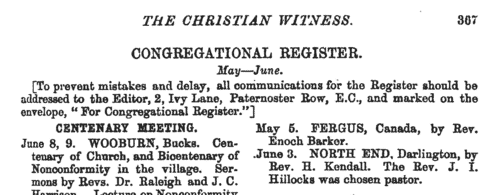
| Congregationalist Ministers: Removals
(1868-1869)
In 'The Christian Witness and Congregational Magazine', published monthly, was a section called 'The Congregational Register', detailing recent Congregationalist activity at home and abroad. It included Ordinations; Recognitions (services when a new minister is introduced to his congregation); Calls Accepted (newly-qualified theological students are appointed to their first posts); Removals (of ministers from one place to another); Resignations; Deaths of Ministers; Deaths of Ministers' Wives; Deaths of Ministers' Widows; and Testimonials (presentations by congregations to long-serving or departing ministers). Precise dates and places are usually given in the case of ordinations, recognition services and deaths. The ministers are referred to by surname and initials; the ministers' wives and widows are never given christian name or initials. The register from New Series volume 5, issued from January to December 1869, covers events from October 1868 to November 1869. | Sample scan, click to enlarge
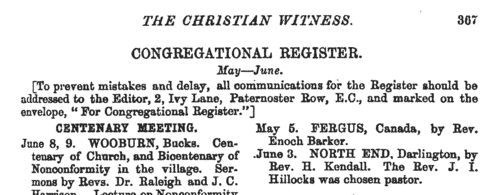
| Congregationalist Ministers: Testimonials
(1868-1869)
In 'The Christian Witness and Congregational Magazine', published monthly, was a section called 'The Congregational Register', detailing recent Congregationalist activity at home and abroad. It included Ordinations; Recognitions (services when a new minister is introduced to his congregation); Calls Accepted (newly-qualified theological students are appointed to their first posts); Removals (of ministers from one place to another); Resignations; Deaths of Ministers; Deaths of Ministers' Wives; Deaths of Ministers' Widows; and Testimonials (presentations by congregations to long-serving or departing ministers). Precise dates and places are usually given in the case of ordinations, recognition services and deaths. The ministers are referred to by surname and initials; the ministers' wives and widows are never given christian name or initials. The register from New Series volume 5, issued from January to December 1869, covers events from October 1868 to November 1869. | Sample scan, click to enlarge
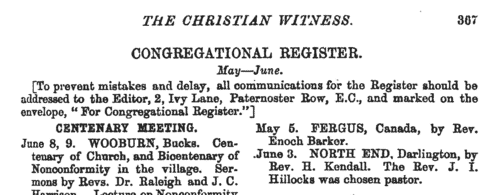
| Boys entering Uppingham School
(1869)
The public school at Uppingham in Rutland was founded by Archdeacon Johnson in 1584. A roll of scholars from 1824 to 1905 was edited by J. P. Graham, and published in 1906. This was a revision and updating of an 1894 edition of the roll, the great bulk of the work having been done by Mrs Mullins. The roll is arranged by year, and within each year by term of entrance, and then alphabetically by surname within each term. Each boy's name is given, surname first, with an asterisk where known (in 1906) to have died. Then there is month and year of birth, father's name (most often just surname and initials) and address (at entrance). Where the boy represented the school at Rugby football (XV) or cricket (XI), that is indicated. After the month and year of leaving the school, there is a brief summary of achievements in later life, and, where known, address as in 1906. | Sample scan, click to enlarge
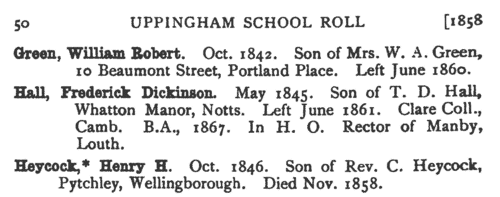
| Deaths
(1869)
Deaths reported in the Pall Mall Gazette, May 1869 | Sample scan, click to enlarge

| Members of the Association for Promoting the Extension of The Contagious Diseases Act, in Cambridge
(1869)
The Contagious Diseases Act of 1866 had as its first objective the establishment of isolation hospitals for the treatment of soldiers and sailors afflicted with smallpox, typhoid, measles, chicken pox, malaria, scarlet fever, bubonic plague, dysentery, enteric fever and other infectious conditions. This association was formed to lobby for the extension of the Act to the civil population of the United Kingdom. The membership was drawn not just from the medical profession and those interested in the administration of the poor law, but also from concerned individuals throughout society. The membership list was published alphabetically by area: the scan shows the start of the names for Leicester. | Sample scan, click to enlarge
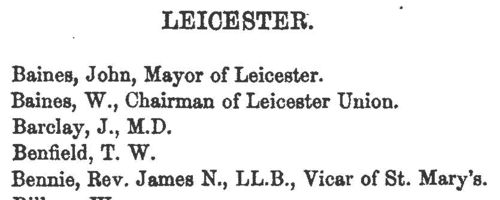
| Patentees of New Inventions
(1869)
Index of patentees and applicants for patents of inventions in 1869: giving full name of patentee (surname first); number of patent (in bold); date (within 1869); and subject-matter. Where the patentee was acting as agent for third parties, their names are given in italics in the subject-matter column. | Sample scan, click to enlarge

| Science Schools and Classes: Elementary Examination: Class Lists
(1869)
The Science and Art Department of the Committee of Council on Education published these class lists giving the names of all the successful candidates in the examination of science schools and classes taken in May 1869. The candidates were of three levels: honours; second stage or advanced examination; third stage or elementary examination. Twenty-three subjects were offered. These are the lists for the elementary examination. The tables, arranged subject by subject, give the candidate's full name (surname first), age, and occupation - or, in the case of those not yet of working age, father's occupation, preceded by (f.). Many candidates sat and were successful in more than one subject, and so appear in more than one list. The subjects are: I. Practical, Plane and Solid Geometry; II. Machine Construction; III. Building Construction; IV. Elementary Mathematics; V. Higher Mathematics; VI. Theoretical Mechanics; VII. Applied Mechanics; VIII. Acoustics, Light, and Heat: IX. Magnetism and Electricity; X. Inorganic Chemistry; XI. Organic Chemistry; XII. Geology; XIII. Mineralogy; XIV. Animal Physiology; XV. Zoology; XVI. Vegetable Anatomy and Physiology; XVII. Systematic and Economic Botany; XVIII. Mining; XIX. Metallurgy; XX. Navigation; XXI. Nautical Astronomy; XXII. Steam; XXIII. Physical Geography. | Sample scan, click to enlarge

| Science Schools and Classes: Honours and Advanced Examinations: Class Lists
(1869)
The Science and Art Department of the Committee of Council on Education published these class lists giving the names of all the successful candidates in the examination of science schools and classes taken in May 1869. The candidates were of three levels: honours; second stage or advanced examination; third stage or elementary examination. Twenty-three subjects were offered. These are the lists for the honours and advanced examinations. The tables, arranged subject by subject, give the candidate's full name (surname first), age, and occupation - or, in the case of those not yet of working age, father's occupation, preceded by (f.); the name of the school where the candidate was taught the subject; and the name of the teacher. Many candidates sat and were successful in more than one subject, and so appear in more than one list. The subjects are: I. Practical, Plane and Solid Geometry; II. Machine Construction; III. Building Construction; IV. Elementary Mathematics; V. Higher Mathematics; VI. Theoretical Mechanics; VII. Applied Mechanics; VIII. Acoustics, Light, and Heat: IX. Magnetism and Electricity; X. Inorganic Chemistry; XI. Organic Chemistry; XII. Geology; XIII. Mineralogy; XIV. Animal Physiology; XV. Zoology; XVI. Vegetable Anatomy and Physiology; XVII. Systematic and Economic Botany; XVIII. Mining; XIX. Metallurgy; XX. Navigation; XXI. Nautical Astronomy; XXII. Steam; XXIII. Physical Geography. | Sample scan, click to enlarge

| The Law Times: Marriage Notices: Grooms
(1869)
Volume 47 of The Law Times, 'The Journal of The Law and The Lawyers', a weekly publication, runs from 1 May to 30 October 1859, issues number 1361 to 1387. Regular features include Birth, Marriage and Death announcements.
| Sample scan, click to enlarge

|
Research your ancestry, family history, genealogy and one-name study by direct access to original records and archives indexed by surname.
|











